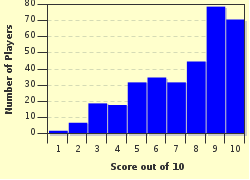Quiz Answer Key and Fun Facts
1. New Orleans is considered the birthplace of jazz. However, most of the great recordings of the 1920s were made in a northern city which gives its name to the two dominant jazz genres of that decade. What city was the 1920s "home base" of Louisiana-born King Oliver, Louis Armstrong and Jelly Roll Morton, as well as Iowa-born Bix Beiderbecke and the young Benny Goodman?
2. The blues has always been a major component of all jazz styles. What style of blues from the 1920s featured great divas like Bessie Smith and Ma Rainy, as well as contributions by great jazz figures like Louis Armstrong and Fletcher Henderson?
3. The commercial heyday of jazz music came in the 1930s and '40s, when jazz forms were the dominant music for dances and social events. Which of these terms is commonly applied to the mainstream jazz of this era?
4. Considered by most to be the first "modern" jazz style, this type of music featured increased harmonic sophistication and greater rhythmic freedom that allowed for greater expression of virtuosity, but did not, by and large, abandon the standard song repertoire in which most of its proponents had been trained. What is this style that is closely identified with musicians like Charlie Parker, Dizzy Gillespie, and Max Roach?
5. As jazz players began to explore more small ensemble forms with greater improvisational freedom, many East Coast musicians began to gravitate toward a style not unlike that of Charlie Parker and Dizzy Gillespie, but with more emphasis on blues and gospel elements. What was this jazz genre, whose exemplars include Benny Golson, Art Blakey, and Horace Silver?
6. Another departure from the work of Parker and Gillespie was a style more closely identified with the West Coast. This jazz genre drew on the examples of Lester Young and Bix Beiderbecke, deemphasizing blues elements in favor of crisper tones, as well as making great use of unusual, syncopated meters as opposed to more aggressive rhythms. What is this jazz style made popular by performers like Stan Getz, Gerry Mulligan and Lee Konitz?
7. As jazz grew increasingly more experimental through the 1950s, some radical musicians questioned the nature of the music, challenging the very idea of composition in a form based on improvisation. The result was an avant-garde style that both intrigued and repulsed jazz fans and remains a bone of contention for aficionados to this day. What is this style that took its name from a landmark 1960 album by Ornette Coleman?
8. Another divisive figure in jazz music was Gunther Schuller, whose work, beginning in the 1950s, sought to combine some elements of classical music with the improvisational techniques of jazz, creating, in Schuller's estimation, a new genre altogether. What is the term that Schuller used for this endeavor?
9. From the late 1950s on, the dominant popular music in the United States (and, increasingly, Europe) was rock and roll. Though much rock music was held in disdain by jazz purists, some accomplished jazz musicians began to explore integrating rock elements into their music in the late 1960s, occasionally reaching "crossover" popularity with new audiences. What name is usually applied to these jazz-rock efforts?
10. Most jazz musicians can be identified with some confidence as being, primarily, exponents of a particular style. Some of the greats, like Herbie Hancock and Freddie Hubbard, have made their marks in multiple genres, or, like John Coltrane and Charles Mingus, have become largely genres unto themselves. One musician, however, is generally recognized as an essential figure in several styles, including cool jazz, hard bop, bebop, avant-garde, and fusion. Who is this trumpet player known for his characteristic Harmon mute?
Source: Author
stuthehistoryguy
This quiz was reviewed by FunTrivia editor
Dalgleish before going online.
Any errors found in FunTrivia content are routinely corrected through our feedback system.


